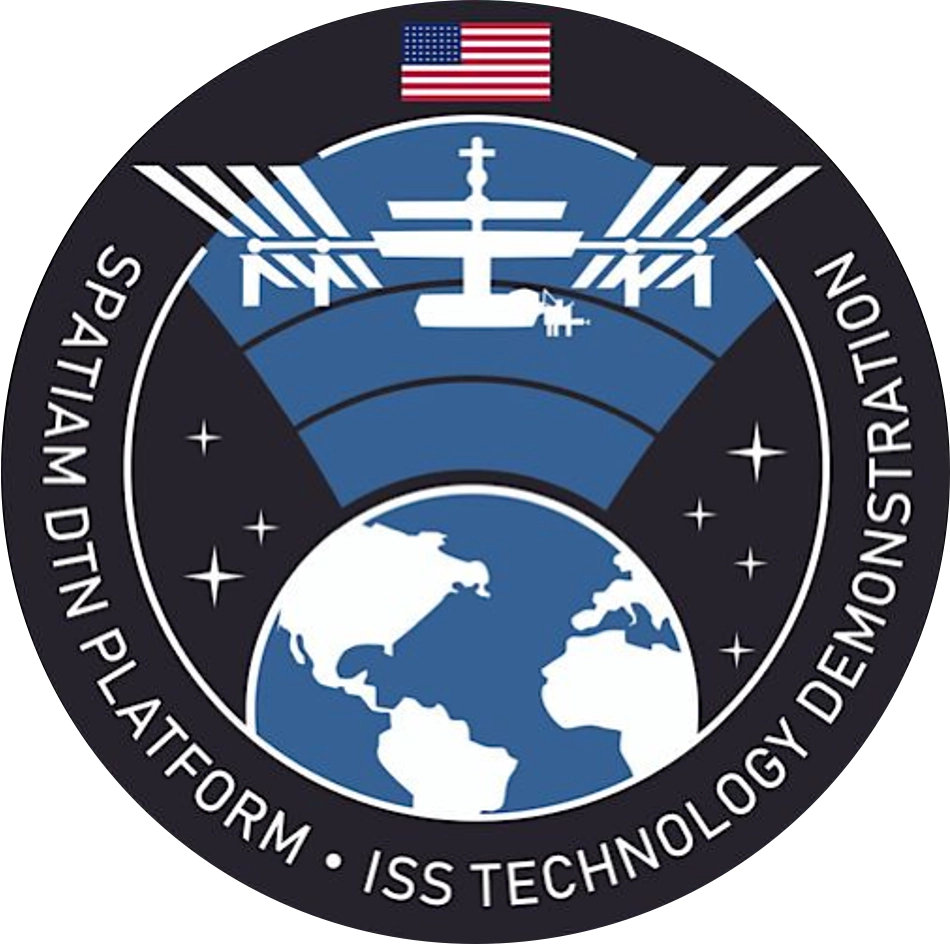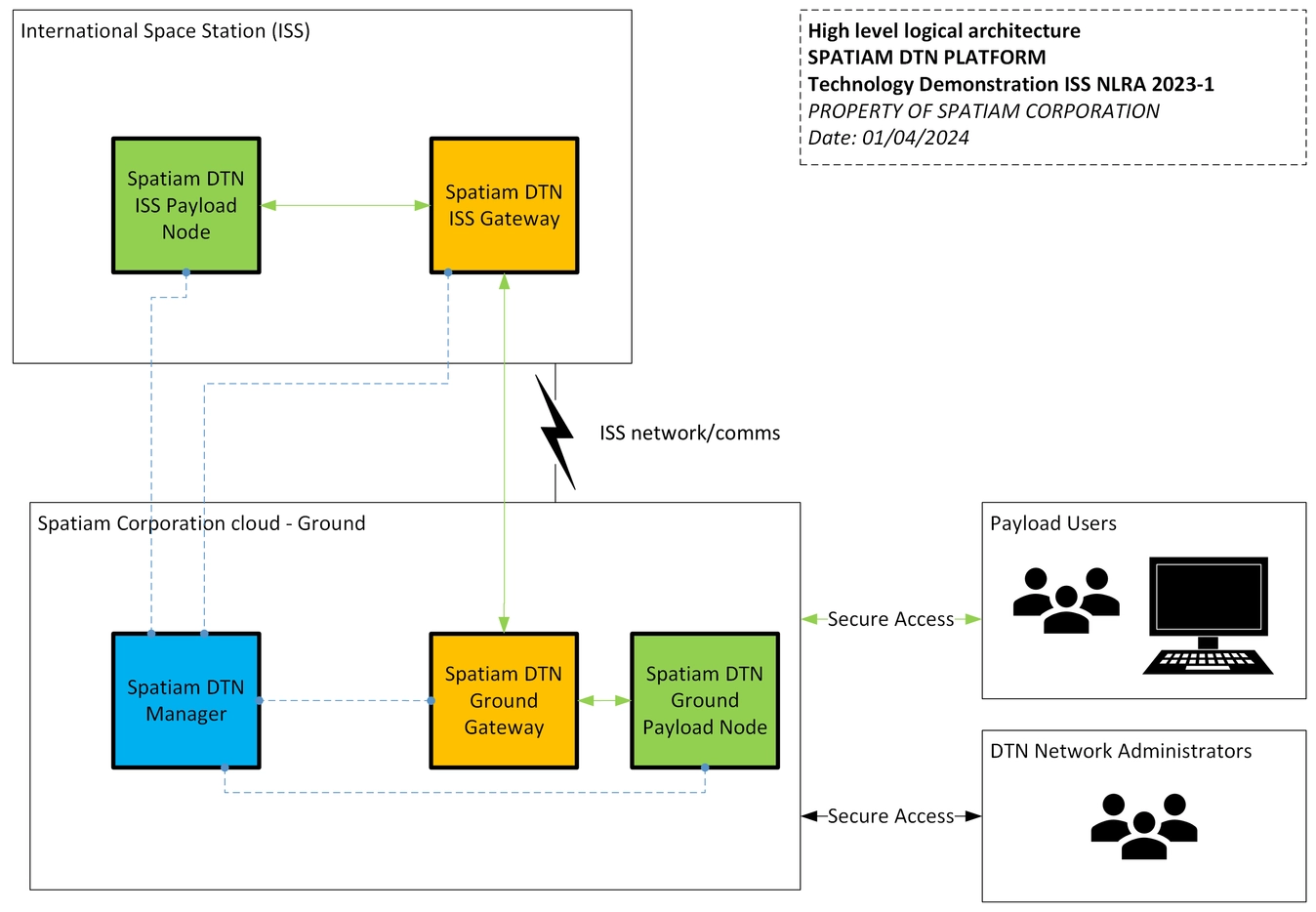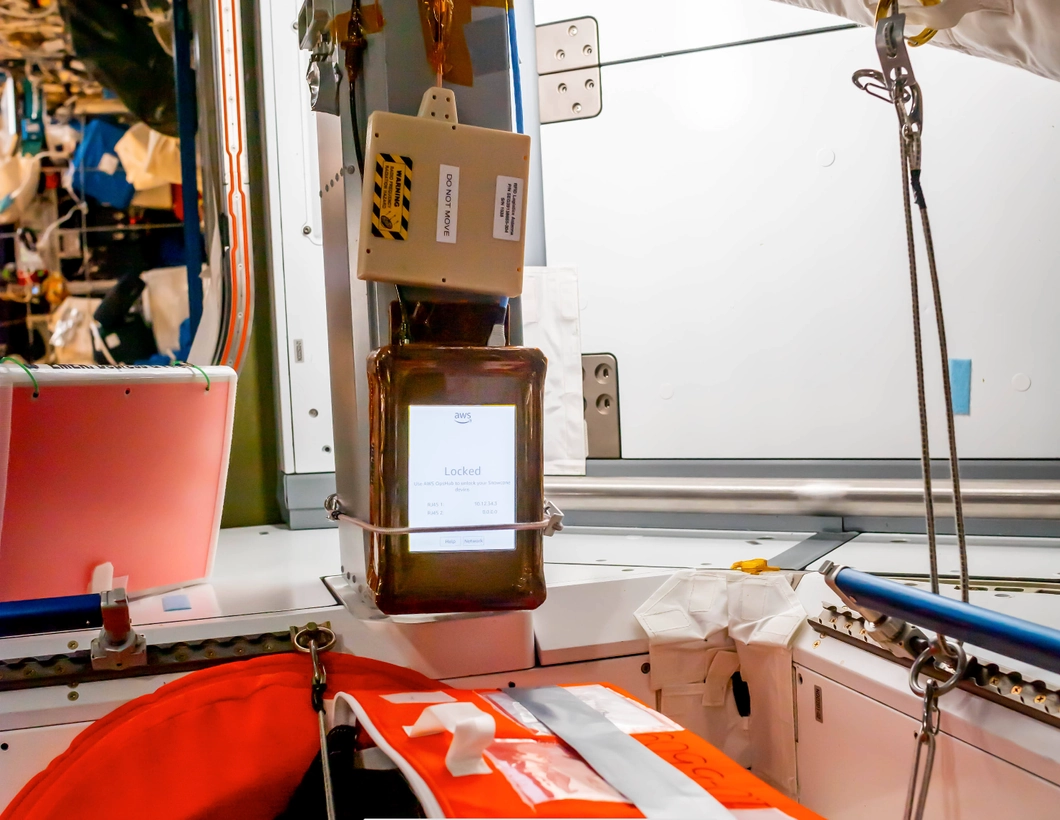This technology demonstration aims to demonstrate the first commercial Delay and Disruption Tolerant Networking (DTN) platform in space, supporting the creation of interoperable DTN Network overlays that are managed, open, and secure.
The demonstration will include the installation, setup, and configuration of a DTN network overlay on the ISS, using the SPATIAM DTN Platform.
The main goal of the demonstration is to improve the Technology Readiness Level of the SPATIAM DTN Platform under the unique conditions of the International Space Station US National Laboratory.

Technology Demonstration Patch.
Background
Spatiam Corporation was awarded a contract through the ISS National Lab Research Announcement 2023-7 (Technology Advancement and Applied Research Leveraging the ISS National Lab) to perform a Technology Demonstration of the SPATIAM DTN Platform on the International Space Station.
Why the International Space Station?
The International Space Station has been in continuous operation for more than 20 years. In 2016, NASA installed and demonstrated the first Delay and Disruption Tolerant (DTN) Network on the ISS. Later, this network became operational and upgraded, and it now supports tens of software (data) payloads. The network makes use of the Bundle Protocol version 6 (BPv6).
The uniqueness of the ISS for this technology demonstration comes from its capabilities and the specifics of the communication links available:
- Communications affected by disruptions.
- Limited bandwidth.
- Space Operations.
System Overview
This technology demonstration will create network overlays between payloads on the ISS and payload users in ground. The figure below depicts the high-level elements of the Spatiam DTN Platform used in the technology demonstration.

High-level logical architecture, from the Technology Demonstration Concepts of Operations.
The SPATIAM DTN Gateway Nodes (in orange) are the nodes that establish the SPATIAM DTN Platform data plane, forwarding bundles between the ISS and ground. Through these nodes, customer data payloads are sent to Earth, and commands, control messages, and files are sent from payload users on Earth to the ISS payloads. Three separate SPATIAM DTN Ground Gateways will be set up using different implementations of the Bundle Protocol stack (NASA/JPL ION, NASA HDTN and D3TN µD3TN) to test the multi-implementation capabilities of the Spatiam DTN Platform.
The SPATIAM DTN Payload Nodes (in green) provide the data and SW payloads (i.e., applications) that send traffic between the ISS and ground users. For this demonstration, the nodes will contain the applications that will provide the test subjects (i.e., data and applications) used to test and validate the SPATIAM DTN Platform.
The SPATIAM DTN Platform elements on the ISS will communicate with the SPATIAM DTN Platform elements in ground via the existing ISS network and links.
The SPATIAM DTN Manager (in blue) contains the management application of the network. From the ground it communicates with the ISS Network through the DTN Global Management Node (not shown), and interfaces with users through a Web Application. Its objective is to manage deployment, configuration, and operations of the network and nodes.
The SPATIAM DTN (Network) Administrators will securely access the SPATIAM DTN Platform in this demonstration to configure, measure, and diagnose the network during the technology demonstration experiments. As such there are three administrators planned, a DTN (Network Overlay) Administrator, and two DTN Node Administrators to test the multi-administration features of the SPATIAM DTN Platform.
The Payload users are users who will send/receive and evaluate data with the payload nodes on the ISS. For this technology demonstration, users will interact with the payload applications to e.g., generate data or validate specific functionality under test.
Interfaces and Physical Characteristics
This technology demonstration relies on the Bundle Protocol version 7 (BPv7) as the end-to-end internetworking layer. The Bundle Protocol will run under multiple convergence layers. The space link will use the LTP on UDP convergence layer, and the local/ground links will use TCP convergence layer.
- On the ISS, the technology demonstration software will be installed in the Amazon Snowcone device on board the ISS, connected through the ISS Local Area Network.
- The Spatiam DTN (ground) cloud components run in the Amazon Web Services (AWS) infrastructure.

Amazon Snowcone on board the ISS. Image credit: NASA.
System Objectives
The main goal of the demonstration is to improve the Technology Readiness Level of the SPATIAM DTN Platform, under the unique conditions of the ISS. This goal will be achieved through the following demonstration objectives.
1 - Demonstrate Core Capabilities of an operational DTN Network in Low-Earth Orbit (LEO)
This objective seeks to demonstrate and validate our readiness to setup a basic network overlay for the transmission of payload data from the ISS to payload users on Earth. This objective will be achieved through the following milestones:
- Validate software in ground.
- Software installation through the ISS and implementation partner operational processes for ISS.
- Setup of DTN network overlay.
- Transfer of payload telemetry data evaluating performance.
- Transfer of command data evaluating performance.
- Contact plan management.
- 24x7 operational planning.
2 - Demonstrate Operational Capabilities of the SPATIAM DTN Manager
The SPATIAM DTN Manager, a core component of the SPATIAM DTM Platform, delivers unique capabilities to operationalize multi-administration, heterogeneous network overlays. This objective seeks to demonstrate how the SPATIAM DTN Manager assists in operationalizing key network functions, including:
- Set up a multi-administrative network overlay with DTN Nodes, where two distinct organizations can manage their own nodes, while participating in a common network overlay.
- Dynamic setup of an interoperable network with multiple DTN Bundle Protocol implementations, including NASA/JPL ION, NASA HDTN and D3TN µD3TN implementations.
- Topology management, including the configuration of nodes as Exit Gateways.
- Dynamic updates of contact plans.
3 - Demonstrate Advanced Capabilities of the SPATIAM DTN Platform
The capabilities below are advanced network capabilities in the DTN Management and data transfer areas. These are considered novel DTN capabilities overall. For Spatiam Corporation, some of these capabilities may be at a lower TRL level.
- Management using a DTN Management Architecture (DTNMA) implementation. Spatiam Corporation is leading the way in having a fully integrated DTN Management architecture. Our platform implements DTN Management following architectural precepts of the IETF DTN Management Architecture (DTNMA). Through the SPATIAM DTN Platform, we will demonstrate the management of nodes and network overlays using a complete DTN Management framework, including node and contact plan management. To our knowledge, this will demonstrate the first commercial platform performing DTN Management for interplanetary networking.
- Advanced topology management with Bundle-in-Bundle Encapsulation (BIBE). This demonstration will expand the concept of Gateway nodes to perform Bundle in Bundle Encapsulation, to simplify even further the configuration of the system and add functionality such as custody transfer. In this set up two gateway nodes (ISS and ground) will communicate acting as BIBE endpoints.
- Secure access using Bundle Protocol Security (BPSec) and application-based access.
- Support Streaming Applications over the Bundle Protocol Bundle Streaming Service (BSSP).
Scientific and Technical Impacts
The main technical impact is the demonstration of a commercially managed, open, DTN Network overlay, using the SPATIAM DTN Platform. In terms of innovation relative to the state of the art, this will be the first demonstration of a commercial end-to-end DTN Platform, with core functionality equivalent to the existing space agency managed DTN networks in space, and extended to cover network management, security, multi-administration, interoperability, and other key internetworking requirements for LunaNet and other interplanetary networks.
In addition, key data and results will be shared with the scientific community to help progress the operationalization of DTN technologies.
Research reported in this project article was awarded through ISS National Lab Research Announcement 2023-7: Technology Advancement and Applied Research Leveraging the ISS National Lab. Spatiam Corporation is working with Axiom Space as the implementation partner.
